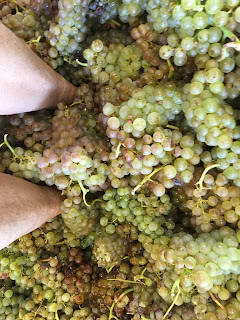What a beautiful autumn it's been!
I've lived in the Siskiyou Mountains for almost fifty years, and every year I forget how beautiful autumn can be. Now that I'm half a century distant from my childhood in the Appalachian hills of north Georgia, too, I've forgotten how gorgeous the Appalachians were. I just don't think autumn could be any more beautiful than it is here.
When I expressed this thought to a friend who grew up in Pennsylvania, he gently reminded me that with the Appalachians in full autumn glory, entire hillsides are ablaze. Here, the hills, covered in evergreens, are ever green, year-round, and are autumnally dull in comparison. And, of course, it's true. I've just forgotten.
But that autumn in the Rogue Valley is not as spectacular as it is in north Georgia or Pennsylvania doesn't mean it isn't mouth-agape beautiful here. The hills might be green, spotted here and there with the deep, butter-rich yellow of maples, but to hike on trails studded with viny maples, dogwoods, and big-leaf maples in and around the firs and cedars
is to come to a standstill with awe in front of now one tree and now another. It's the individual tree, in the Siskiyou autumn, that astonishes, not the broad, sweeping panorama. It's the blazing red maple at the bottom of Thomspon Creek Road that I call my favorite autumn tree in the Applegate. It's the canopy of big-leaf maples so yellow I stop the car, get out, and slip-slide down the hill just so I can stand under them, where the air itself has turned yellow, and absorb that color through my skin. It's Lithia Park in Ashland, where autumn-rich trees are reflected in the pond,
and Riverside Park in Grants Pass, with its tall, magnificent yellow, orange, and red trees. It's this tree of umber, that one of scarlet, the next one of bronze, the next of pink.
Earlier this autumn, when I was walking up a trail on the mountain, I stopped in amazement before a glowing big-leaf maple at the edge of the trail. I gawked for a long time, awash in the colors of that tree, and I wondered if the deer and cougars who walked this same trail were aware of that beauty, whether the tree itself were aware of its own exquisitneness. Could the creatures of the woods walk through autumn's glory without noticing? It seems impossible, but it also seems true that all that beauty was just there for its own sake, whether I was there to see it or not, whether any being was there to appreciate it.
Thomas Berry tells us, in his wonderful book The Dream of the Earth, "The human is that being in whom the universe comes to itself in a special mode of conscious reflection," or, as physicist Brian Swimme puts it, "The universe shivers with wonder in the depths of the human." That, I think, is what I was experiencing as I absorbed what I was seeing in the maple tree and its surrounding mountains: myself as the consciousness of the universe. It is a responsibility of all of us as we walk through this world.














